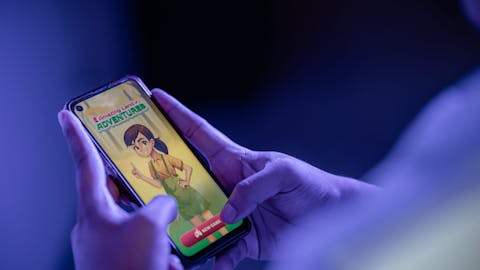When the Climate Crisis Becomes a Child Protection Crisis
Why COP30 must make child protection central to both adaptation and mitigation strategies
As leaders gather for COP30 in Belém, Brazil, the world faces a critical truth: while the climate crisis accelerates, children are already paying the highest price. Droughts, floods, and storms are destroying livelihoods, forcing families to move, and leaving children more exposed to child labour, child marriage, and sexual exploitation. Now, as the world transitions to renewable energy, we risk adding new dangers. If the green transition isn’t managed responsibly, the demand for critical minerals, such as cobalt, lithium, and nickel, can draw children into hazardous mining and sexual abuse and exploitation.
The climate crisis is not only an environmental emergency. It is a child protection emergency.
Climate shocks and collapsing safety nets
When livelihoods collapse, schools close, or families are displaced, protection systems fracture. Around the world, these pressures translate into three growing risks:
- Child labour: Families struggling with drought or disaster often rely on children to supplement income, leading to long hours in hazardous sectors such as agriculture or mining.
- Child marriage: Economic desperation and food insecurity push some families to marry off their daughters early, believing it offers safety or stability. In reality, it deepens gender inequality and exposure to abuse.
- Sexual exploitation: Traffickers exploit crises. Displacement, poverty, and online isolation create openings for sexual coercion and grooming, both offline and online.
A child-unsafe energy transition
While COP30 rightly calls for a phase-out of fossil fuels, the path to a greener future must also be just and child-safe. The global energy transition depends on minerals mined under conditions that often violate children’s rights. In the Democratic Republic of Congo, children work in hazardous artisanal cobalt mines that supply electric vehicles and solar panels. In India and Madagascar, children collect mica used in electronics and renewable technologies. Around mining zones in Africa, rising cash economies have turned these areas into hotspots for sexual and gender-based violence.
The Child Rights International Network (CRIN) and its youth advisers have called on COP30 delegates to recognise this reality, demanding that governments “take immediate action to stop all instances of child labour in energy transition projects”, and that any company proven to use child labour in mineral extraction be excluded from compensation.If mitigation is pursued without human rights safeguards, we risk replacing one exploitative system with another, fuelling green industries through the suffering of children.
Why child protection belongs at the heart of climate action
To protect children, climate action must go beyond only infrastructure and emissions. It must rebuild the social systems and accountability mechanisms that keep families and communities safe.
Five Priorities for COP30 and Beyond
1. Integrate child protection into climate action.
Embed prevention, case management, and mental health and psychosocial support (MHPSS) into National Adaptation Plans and Loss & Damage frameworks to ensure children’s safety and well-being are central to climate resilience.
2. Protect education during crises.
Invest in climate-resilient schools, emergency cash transfers, and flexible re-enrolment systems to prevent school dropouts, child labour, and early marriage during and after climate shocks.
3. Strengthen family livelihoods.
Expand social protection and promote climate-resilient jobs to reduce the economic pressures that push children into labour, exploitation, or migration.
4. Safeguard children’s online and offline safety in emergencies.
Regulate technology platforms, support helplines, and train frontline responders to detect, prevent, and respond to exploitation and abuse in crisis settings.
5. Make the energy transition child-safe.
Mandate child rights due diligence in critical mineral supply chains, invest in safe and sustainable livelihoods in mining communities, and integrate child protection indicators into all just transition frameworks.
6. Put children at the centre of climate decisions.
Guarantee meaningful child participation in climate policy, planning, and action so that their perspectives shape the solutions that affect their futures.
Children are already being impacted by climate change. Action can no longer wait.
A COP30 call to action
If COP30 delivers new climate finance, that funding must reach children, through protection, education, and safe transitions.Countries must ensure that climate finance supports both adaptation and a just transition that upholds children’s rights. True climate justice means that the shift to clean energy cannot come at the expense of the world’s poorest and youngest.
Because protecting the planet and protecting children are not separate goals,
they are the same fight.

References
Amnesty International, & Afrewatch. (2016). This is what we die for: Human rights abuses in the Democratic Republic of the Congo power the global trade in cobalt. Amnesty International. https://www.amnesty.org/fr/wp-content/uploads/2021/05/AFR6231832016ENGLISH.pdf
Child Rights International Network. (2024). Children and young people call for action at COP30. CRIN. https://crin.org
ECPAT International. (2022). Global study on sexual exploitation of children in emergency contexts. ECPAT International. https://ecpat.org
International Labour Organization, & UNICEF. (2021). Child labour: Global estimates 2020, trends and the road forward. ILO & UNICEF. https://www.ilo.org/global/publications/books/WCMS_797515
Pact. (2024, June 12). To combat child labor in Madagascar’s mica mining sector, Pact focuses on families. https://www.pactworld.org/blog/combat-child-labor-madagascars-mica-mining-sector-pact-focuses-families
Save the Children. (n.d.). DRC: Cobalt mines, child labour and the green transition. https://www.savethechildren.net/stories/drc-cobalt-mines-child-labour-and-green-transition
SOMO, & Terre des Hommes Netherlands. (2019). Child labour in Madagascar’s mica sector: Impact of the mica supply chain on children’s rights. SOMO. https://www.somo.nl/wp-content/uploads/2019/11/tdh-mica_madagascar_rapport.pdf
UNICEF. (2021). Child marriage: Latest trends and future prospects. UNICEF. https://data.unicef.org/resources/child-marriage-latest-trends-and-future-prospects/





